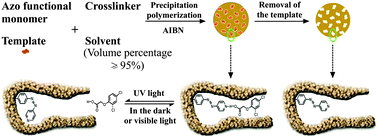Azobenzene-containing molecularly imprinted polymer microspheres with photoresponsive template binding properties†
Abstract
The first successful preparation of azobenzene (

* Corresponding authors
a
Key Laboratory of Functional Polymer Materials (Nankai University), Ministry of Education, Department of Chemistry, Nankai University, Tianjin, P. R. China
E-mail:
zhanghuiqi@nankai.edu.cn
Fax: +86 2223507193
Tel: +86 2223507193
The first successful preparation of azobenzene (

 Please wait while we load your content...
Something went wrong. Try again?
Please wait while we load your content...
Something went wrong. Try again?
L. Fang, S. Chen, Y. Zhang and H. Zhang, J. Mater. Chem., 2011, 21, 2320 DOI: 10.1039/C0JM02898C
To request permission to reproduce material from this article, please go to the Copyright Clearance Center request page.
If you are an author contributing to an RSC publication, you do not need to request permission provided correct acknowledgement is given.
If you are the author of this article, you do not need to request permission to reproduce figures and diagrams provided correct acknowledgement is given. If you want to reproduce the whole article in a third-party publication (excluding your thesis/dissertation for which permission is not required) please go to the Copyright Clearance Center request page.
Read more about how to correctly acknowledge RSC content.
 Fetching data from CrossRef.
Fetching data from CrossRef.
This may take some time to load.
Loading related content
